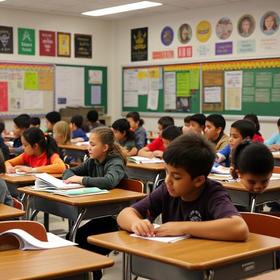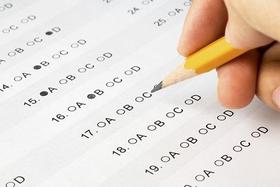Wood End School is an elementary school in Reading, Massachusetts, United States. There were 246 students in grades K–5 and 21 staff members in 2022. The school was recognized in 2008 as a "Beacon of Light" school by the Blue Ribbon School of Excellence Program.
Serving 249 students in grades Kindergarten-5, Wood End Elementary School ranks in the top 30% of all schools in Massachusetts for overall test scores (math proficiency is top 30%, and reading proficiency is top 30%).
The percentage of students achieving proficiency in math is 55-59% (which is higher than the Massachusetts state average of 42%). The percentage of students achieving proficiency in reading/language arts is 55-59% (which is higher than the Massachusetts state average of 44%).
The student-teacher ratio of 12:1 is equal to the Massachusetts state level of 12:1.
Minority enrollment is 15% of the student body (majority Asian and Hispanic), which is lower than the Massachusetts state average of 47% (majority Hispanic).
Quick Facts (2025-26)
- Grades: Kindergarten-5
- Enrollment: 249 students
- Student-Teacher Ratio: 12:1
- Minority Enrollment: 15%
- Overall Testing Rank: Top 30% in MA
- Math Proficiency: 55-59% (Top 30%)
- Reading Proficiency: 55-59% (Top 30%)
- Science Proficiency: 80-89% (Top 1%)
- Source: National Center for Education Statistics (NCES), MA Dept. of Education
Top Rankings
Wood End Elementary School ranks among the top 20% of public schools in Massachusetts for:
Category
Attribute
Science Proficiency
Community Size
School Overview
Wood End Elementary School's student population of 249 students has declined by 18% over five school years.
The teacher population of 20 teachers has declined by 9% over five school years.
Grades Offered
Grades Kindergarten-5
(Supplemental Virtual)
(Supplemental Virtual)
Total Students
249 students
Gender %
Total Classroom Teachers
20 teachers
School Calendar
School Rankings
Wood End Elementary School ranks within the top 30% of all 1,626 schools in Massachusetts (based off of combined math and reading proficiency testing data).
The diversity score of Wood End Elementary School is 0.27, which is less than the diversity score at state average of 0.65. The school's diversity has stayed relatively flat over five school years.
Overall Testing Rank
#408 out of 1626 schools
(Top 30%)
(Top 30%)
Math Test Scores (% Proficient)
55-59%
42%
Reading/Language Arts Test Scores (% Proficient)
55-59%
44%
Science Test Scores (% Proficient)
80-89%
44%
Student-Teacher Ratio
12:1
12:1
American Indian
n/a
n/a
Asian
6%
7%
Hispanic
4%
25%
Black
2%
10%
White
85%
53%
Hawaiian
n/a
n/a
Two or more races
3%
5%
All Ethnic Groups
Participates in the National School Lunch Program (NSLP)
Yes
Eligible for Free Lunch
8%
35%
Eligible for Reduced Lunch
2%
4%
School Statewide Testing
School District Name
Source: National Center for Education Statistics (NCES), MA Dept. of Education
Profile last updated: 02/09/2025
Frequently Asked Questions
What is Wood End Elementary School's ranking?
Wood End Elementary School is ranked #408 out of 1,626 schools, which ranks it among the top 30% of public schools in Massachusetts.
What percent of students have achieved state testing proficiency in math and reading?
55-59% of students have achieved math proficiency (compared to the 42% MA state average), while 55-59% of students have achieved reading proficiency (compared to the 44% MA state average).
How many students attend Wood End Elementary School?
249 students attend Wood End Elementary School.
What is the racial composition of the student body?
85% of Wood End Elementary School students are White, 6% of students are Asian, 4% of students are Hispanic, 3% of students are Two or more races, and 2% of students are Black.
What is the student-teacher ratio of Wood End Elementary School?
Wood End Elementary School has a student ration of 12:1, which is equal to the Massachusetts state average of 12:1.
What grades does Wood End Elementary School offer ?
Wood End Elementary School offers enrollment in grades Kindergarten-5 (Supplemental Virtual).
What school district is Wood End Elementary School part of?
Wood End Elementary School is part of Reading School District.
School Reviews
Review Wood End Elementary School. Reviews should be a few sentences in length. Please include any comments on:
- Quality of academic programs, teachers, and facilities
- Availability of music, art, sports and other extracurricular activities
Recent Articles

How Public Schools Support Students on Free / Reduced-Lunch Programs
Explore how U.S. public schools support students eligible for free or reduced-price lunch through nutrition, academic, and wraparound services in 2025.

Hidden Costs of Public Schools: Fees, Supplies & Extras
Explore the hidden costs in public schools—fees, supplies, extracurriculars—and how parents can plan for them in 2025.

Public School Funding 2025: What Families Should Know
Essential insights on public school funding in 2025—how it works, what’s changing, and what families should know to stay ahead.







